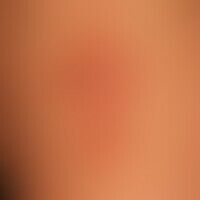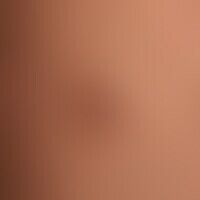Image diagnoses for "Plaque (raised surface > 1cm)", "red", "Leg/Foot"
125 results with 293 images
Results forPlaque (raised surface > 1cm)redLeg/Foot

Tinea cruris B35.8
Tinea cruris: chronic plaque, slightly faded at the centre, accentuated at the edges, large, moderately itchy plaque with interspersed pustules and inflamed papules.

Lichen planus (overview) L43.-
Lichen planus exanthematicus: disseminated sowing of small red papules and confluent plaques.

Hypertrophic Lichen planus L43.81
Lichen planus verrucosus: a hypertrophic lichen planus with pseudoepitheliomatous epithelial hypertrophy and scarring that has been present for several years.

Eosinophilic cellulitis L98.3
Cellulitis eosinophil: acute formation of circumscribed, large, sharply margined plaques, the surface of which may have an orange peel-like texture.

Nummular dermatitis L30.0
Nummulardermatitis (nummular/microbial eczema): Chronically active, 8-week-old, approx. 6 cm large, brownish, raised, partly eroded, partly crusty plaque on the back of the foot in a 54-year-old man. The surrounding skin is reddened.

Dyshidrotic dermatitis L30.8
Eczema, dyshidrotic: Chronic recurrent, slightly infiltrated, sharply defined red plaque on the right foot; reddish-brown, sometimes scaly, dot-shaped, older white scaly papules appear in places where water clear vesicles were previously present.

Lupus erythematosus acute-cutaneous L93.1
lupus erythematosus acute-cutaneous: clinical picture known for several years, occurring within 14 days and still with relapsing course at the time of admission. in contrast to the anular pattern on the trunk, irregular, blurred red plaques. in the current relapsing phase fatigue and exhaustion. ANA 1:160; anti-Ro/SSA antibodies positive. DIF: LE - typical.

Nummular dermatitis L30.0
Nummular dermatitis: Extensive nummular lesions that havebeen present for several months with blurred, considerably itchy papules and confluent plaques. No hinwesi for psoriasis. No evidence of atopic diathesis.

Sarcoidosis of the skin D86.3
sarcoidosis. small-nodular, disseminated sarcoidosis in a 45-year-old man. development of the depicted skin lesions over a period of 6 months. findings: extensive, reddish-brownish, completely asymptomatic, little infiltrated, barely pinhead-sized flat papules, which have conflued to flat plaques. recess of the contact point of the wristwatch. no evidence of system involvement.

Pagetoid reticulosis C84.4
Reticulosis, pagetoid (disseminated type Ketron and Goodman): For several years slowly migrating, partly anular, partly garland-shaped, little itchy, brown-red, only minimally elevated, broadly margined plaques with parchment-like surface.

Psoriasis palmaris et plantaris (overview) L40.3

Asymmetrical nevus flammeus Q82.5
Naevus flammeus: congenital, unilateral, chronically inpatient, bizarre, sharply defined, symptomless naevus flammeus; increasing thickness of vascular lesions with a tendency to focal bleeding after banal trauma.

Pemphigus chronicus benignus familiaris Q82.8
Pemphigus chronicus benignus familiaris: migrating, circulatory plaques covered with scales and crusts

Infant haemangioma (overview) D18.01

Psoriasis (Übersicht) L40.-
Psoriasis of the feet: here partial manifestation in the context of generalised psoriasis.









